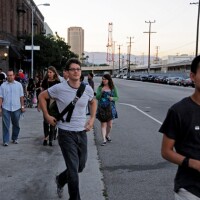Mixed Community Response to Sixth Street Viaduct Replacement Project

With over 100 individuals in attendance, community members gathered in droves at a recent public briefing to learn about the updates in the Sixth Street Viaduct Replacement Project.
Seen in popular films like "Grease," the Sixth Street Viaduct, was constructed in 1932, and is among 14 historic Los Angeles River crossing structures. Its condition has been in decline over the years due to Alkali-Silica Reactions (ASR), otherwise known as "concrete cancer," where a high alkali content found in the concrete produces a chemical reaction that leaves crackling throughout the structure, and comprises its strength. Possible infrastructure failure during an earthquake due to ASR makes restoration impossible.
The replacement project will demolish and replace the existing Sixth Street Viaduct, which spans 3,500 feet over the 101 Freeway, Los Angeles River, railroad corridors and nearby industrial properties. On Thursday, December 5, a public briefing was held at the Boyle Heights City Hall on the estimated $401 million project.
Some residents felt as if their questions were answered, while others argued that specific details to their inquiries were not provided.
"My main concern is quality of life in this whole process -- I want to stay living here, but I want to make a choice and I'm seeking information on whether I choose to stay in this area or not," said Thomas Trafelet, a 10-year resident of Factory Place Arts Complex. "The mitigation of traffic is a very big quality of life issue."
Small business owners were also concerned about parking, street congestion, and other construction-related issues. Alfred Mata, principal civil engineer for the city of Los Angeles, was on hand to answer questions, but noted that traffic concerns would vary by individual location.
Kathleen Kiralla, of Holiday Auto Center on Whittier Boulevard, was one of few concerned about the effect the project would have on her business. "We're just wondering how that's going to impact our property -- if customers are going to be able to access our business," she said.

Future construction activities were discussed at the meeting, including building demolition and utility relocation. Approximately 15 buildings, which conflict with the new viaduct alignment, will be demolished to make way for new construction; this activity is projected to begin next summer. In addition, a number of electrical lines will be relocated underground; this activity is projected to begin next summer.
Viaduct demolition is also slated to take place for six to nine months, beginning no earlier than December 2014, with the closure of Sixth Street/Whittier Boulevard. The closure limits is Sixth Street/Mateo Street at the west end, and Whittier Boulevard/Boyle Avenue at the east end; the northbound onramp to the 101 Freeway will remain open. Foundation work for the new viaduct will begin in spring 2015, with some work performed at night to accommodate businesses, railroads and traffic.
Felicia Filer, the director of public art for the Department of Cultural Affairs of the city of Los Angeles, also presented information on the Viaduct Art Program, integrated public art that will be installed during construction. With an approximate budget of $1.3 million, primary considerations in the public art program include architectural vision, muralism, and opportunities for local artists.
"There was a decision to do something iconic on this bridge, to respond to this large, impressive design of the bridge," Filer said. "It sounds like a lot of money but, to do something grand, we're going to need all of it."
Some individuals highlighted the concerns of local artists.
"The art community is being shortchanged of what they are owed -- the art community should have one percent of the total budget," said David R. Diaz, a professor at California State University, Los Angeles. "It's also going to have a dramatic negative impact on existing small business on both sides of the bridge. I'm very concerned that this should be reconfigured, and there should be funds given to small businesses to help them subsidize their rent and business operations, so that this project doesn't kill the kind of businesses that have created stability and strength for East Los Angeles and the other side of the bridge."
This the third community meeting this year for public feedback; first was held in April at the PUENTE Learning Center, another was held in May at Art Share L.A. Former Mayor Antonio Villaraigosa, Councilmember Jose Huizar, and the Bureau of Engineering first announced an international design competition in April 2012, and HNTB Corporation was selected as the designer on October 2012. Funding is primarily from the Federal Highway Bridge Program, with matching funds from the State Proposition Seismic Safety Retrofit Program.


